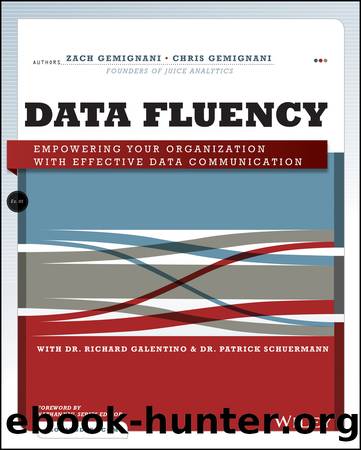Data Fluency by unknow

Author:unknow
Language: eng
Format: epub
ISBN: 9781118851005
Publisher: Wiley
Published: 2014-10-02T00:00:00+00:00
Language
Data products need more than data. The effective use of words can make the difference between understanding and confusion to your audience. When considering the language used to explain your data, the principle objective is to be understood by your target audience. In most cases, you can benefit from choosing common, natural language over complex jargon, and using fewer, simpler words. For example, within the medical world it may be understood that cephalalgia is a medical term for headache, but if you tell the average person that you have a cephalalgia, he may wonder if that’s a disease or some kind of growth. If the users of your data product need to look up terms or ask what an acronym means, you’ve distracted from the purpose of the data product.
As with everything else in authoring data products, audiences come first. Consider how language can be tailored to the way your audiences speak. What terms are they familiar with? Do they understand the meaning behind complex metrics? For internal audiences, commonly used shorthand may be perfectly accessible. But when crossing different functional areas, the familiarity with terminology may dissipate. It is better to err on the side of expressing concepts in simple and more explicit terms. CPC and PPC are well understood in marketing, but a finance executive is better served by referring to “cost-per-click” or “pay-per-click” advertising. The importance of language becomes even more pronounced when crossing organizational and international boundaries.
Many marketers, web designers, and consultants have established a “voice” in their writing that creates a balance between friendly and professional. The goal of business writing is described by Carter Daniel in his book Reader-Friendly Reports (McGraw-Hill, 2012):
Business writing isn’t a different language with a separate set of words and phrases. In receipt of, as per your request, beg to acknowledge, and please be advised are relics of the past. They aren’t used anymore, or shouldn’t be anyway.
Business writing also isn’t dull and stereotyped. Bad writing is dull; good writing is interesting. These statements are true for all writing, business or any other kind. If you are interested in the subject but find the report dull, something’s wrong with the way the report is written.
Business writing is like any other form of writing except more efficient. Think for a minute about who your audience is, and you’ll understand the reason for insisting on efficiency. Business people are intelligent, suspicious, and busy. So when you write for them you have to be factual, persuasive, and efficient: factual because they are too intelligent to be fooled by vagueness and bluffing; persuasive because you have to overcome the suspicion that always accompanies money matters; and efficient because you’ll lose your reader if you waste time.
Download
This site does not store any files on its server. We only index and link to content provided by other sites. Please contact the content providers to delete copyright contents if any and email us, we'll remove relevant links or contents immediately.
Algorithms of the Intelligent Web by Haralambos Marmanis;Dmitry Babenko(16319)
Azure Data and AI Architect Handbook by Olivier Mertens & Breght Van Baelen(7676)
Building Statistical Models in Python by Huy Hoang Nguyen & Paul N Adams & Stuart J Miller(7658)
Serverless Machine Learning with Amazon Redshift ML by Debu Panda & Phil Bates & Bhanu Pittampally & Sumeet Joshi(7533)
Driving Data Quality with Data Contracts by Andrew Jones(7296)
Data Wrangling on AWS by Navnit Shukla | Sankar M | Sam Palani(7291)
Machine Learning Model Serving Patterns and Best Practices by Md Johirul Islam(7032)
Learning SQL by Alan Beaulieu(6240)
Weapons of Math Destruction by Cathy O'Neil(6221)
Big Data Analysis with Python by Ivan Marin(5941)
Data Engineering with dbt by Roberto Zagni(4935)
Solidity Programming Essentials by Ritesh Modi(4568)
Time Series Analysis with Python Cookbook by Tarek A. Atwan(4403)
Pandas Cookbook by Theodore Petrou(4088)
Blockchain Basics by Daniel Drescher(3544)
Natural Language Processing with Java Cookbook by Richard M. Reese(3148)
Hands-On Machine Learning for Algorithmic Trading by Stefan Jansen(3052)
Learn T-SQL Querying by Pam Lahoud & Pedro Lopes(2936)
Feature Store for Machine Learning by Jayanth Kumar M J(2929)
